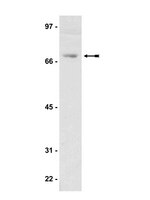Identification of two human WAVE/SCAR homologues as general actin regulatory molecules which associate with the Arp2/3 complex.
Suetsugu, S, et al.
Biochem. Biophys. Res. Commun., 260: 296-302 (1999)
1998
Afficher le résumé
WAVE/SCAR protein was identified as a protein which has similarity to WASP and N-WASP, especially in its C terminal. Recently, WAVE/SCAR protein has been shown to cooperate with the Arp2/3 complex, a nucleation core for actin polymerization in vitro. However, in spite of its general function, WAVE/SCAR expression is mainly restricted to the brain, suggesting the existence of related molecule(s). We here identified two human WAVE/SCAR homologues, which cover other organs. We named the original WAVE1 and newly identified ones WAVE2 and WAVE3. WAVE2 had a very wide distribution with strong expression in peripheral blood leukocytes and mapped on chromosome Xp11.21, next to the WASP locus. WAVE3 and WAVE1 had similar distributions. WAVE3 was strongly expressed in brain and mapped on chromosome 13q12. WAVE1 was mapped on chromosome 6q21-22. Ectopically expressed WAVE2 and WAVE3 induced actin filament clusters in a similar manner with WAVE1. These actin cluster formations were suppressed by deletion of their C-terminal VPH (verproline homology)/WH2 (WASP homology 2) domain. Further, WAVE2 and WAVE3 associate with the Arp2/3 complex as does WAVE1. Our identification of WAVE homologues suggests that WAVE family proteins have general function for regulating the actin cytoskeleton in many tissues. | 10381382
 |
Scar1 and the related Wiskott-Aldrich syndrome protein, WASP, regulate the actin cytoskeleton through the Arp2/3 complex.
Machesky, L M and Insall, R H
Curr. Biol., 8: 1347-56 (1998)
1998
Afficher le résumé
BACKGROUND: The actin-related proteins Arp2 and Arp3 are part of a seven-protein complex which is localized in the lamellipodia of a variety of cell types, and in actin-rich spots of unknown function. The Arp2/3 complex enhances actin nucleation and causes branching and crosslinking of actin filaments in vitro; in vivo it is thought to drive the formation of lamellipodia and to be a control center for actin-based motility. The Wiskott-Aldrich syndrome protein, WASP, is an adaptor protein implicated in the transmission of signals from tyrosine kinase receptors and small GTPases to the actin cytoskeleton. Scar1 is a member of a new family of proteins related to WASP, and it may also have a role in regulating the actin cytoskeleton. Scar1 is the human homologue of Dictyostelium Scar1, which is thought to connect G-protein-coupled receptors to the actin cytoskeleton. The mammalian Scar family contains at least four members. We have examined the relationships between WASP, Scar1, and the Arp2/3 complex. RESULTS: We have identified WASP and its relative Scar1 as proteins that interact with the Arp2/3 complex. We have used deletion analysis to show that both WASP and Scar1 interact with the p21 subunit of the Arp2/3 complex through their carboxyl termini. Overexpression of carboxy-terminal fragments of Scar1 or WASP in cells caused a disruption in the localization of the Arp2/3 complex and, concomitantly, induced a complete loss of lamellipodia and actin spots. The induction of lamellipodia by platelet-derived growth factor was also suppressed by overexpression of the fragment of Scar1 that binds to the Arp2/3 complex. CONCLUSIONS: We have identified a conserved sequence domain in proteins of the WASP family that binds to the Arp2/3 complex. Overexpression of this domain in cells disrupts the localization of the Arp2/3 complex and inhibits lamellipodia formation. Our data suggest that WASP-related proteins may regulate the actin cytoskeleton through the Arp2/3 complex. | 9889097
 |









